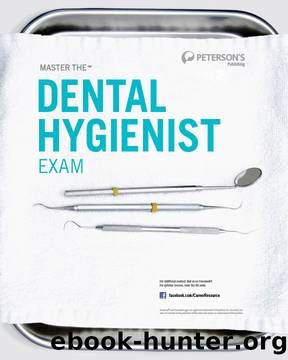Master the Dental Hygienist Exam by Peterson's

Author:Peterson's
Language: eng
Format: epub
Publisher: Peterson's
Published: 2012-11-15T00:00:00+00:00
Component B
Directions: Study the case components and answer questions 1â10.
1. How often should periapical X-rays of this patientâs implants be taken?
(A) Every 6 months
(B) At every maintenance visit
(C) Once a year for 3 years, then every other year
(D) At least once per year
2. What is the BEST indicator for diagnosis of implant failure in this patient?
(A) No bleeding upon probing around the implant
(B) No tissue inflammation around the implant
(C) No mobility around the implant
(D) No deep pocket depths around the implant
3. All of the following are characteristic of a healthy implant site EXCEPT one. Which one is the EXCEPTION?
(A) Firm pink tissue that does not bleed when probed
(B) Only small amounts of purulence when tissue around implant is compressed
(C) Radiographic evidence of bone in close contact with implant
(D) Radiographic bone levels with minimal change from previous
4. When taking radiographs of the implant site, which of the following allows for optimum evaluation?
(A) A vertical bitewing taken in duplicate to be sent to the periodontist
(B) A periapical taken utilizing a long-cone paralleling technique
(C) A periapical that is foreshortened so that we can be assured of seeing the apex
(D) A panograph in order to get a visual of the entire mouth
5. The patient tells you that he no longer wishes to alternate maintenance visits with the periodontist. How do you respond?
(A) âYou have no choice in the matter. You are legally obligated to follow the treatment plan.â
(B) âIâd like to hear your concerns, and then we can discuss this with the doctor when he comes in to do your exam.â
(C) âYou are the patient, and it is your decision, but I think you are making a big mistake.â
(D) âIâm not sure I blame you! It is time-consuming to see both the dentist and the periodontist.â
6. The patient has no significant periodontal findings; his implants were placed 6 years ago because his teeth were knocked out in a fight. Does he require alternating 3-month maintenance visits with the periodontist?
(A) Yes, the periodontist placed the implants and needs to monitor them.
(B) Yes, the patient has generalized recession of less than 2 mm in addition to 4 surgical implants.
(C) Most likely not; the general practitioner and the hygienist have monitored the patientâs implants for 6 years and have provided effective maintenance.
(D) No, the patient could have stopped seeing the periodontist after the first 6 months following implant surgery.
7. All of the following are reasons why traditional metal curets are contraindicated around implant components EXCEPT one. Which one is the EXCEPTION?
(A) If the titanium is scratched, there will be an increase in plaque retention.
(B) If the titanium is scratched, there is an increased likelihood of periimplantitis.
(C) There are other instruments that are more versatile and better promote tissue safety.
(D) Metal can disturb the surface coating of the implant resulting in biocompatibility with periimplant tissues.
8. Should the hygienist polish the implant during the maintenance visit?
(A) No, only the dentist should polish implants.
(B) No, unless surface alterations are noted.
(C) Yes, but a prophy jet should be used.
Download
This site does not store any files on its server. We only index and link to content provided by other sites. Please contact the content providers to delete copyright contents if any and email us, we'll remove relevant links or contents immediately.
Atlas of Orthodontics by Unknown(115)
How To Become Dentally Self-Sufficient by Unknown(107)
Evidence-Based Periodontal and Peri-Implant Plastic Surgery: A Clinical Roadmap from Function to Aesthetics by Leandro Chambrone(99)
Master the Dental Hygienist Exam by Peterson's(94)
Orthodontic Pearls - A Selection of Practical Tips and Clinical Expertise, Second Edition by Eliakim Mizrahi (Editor)(82)
Orthodontic Evidence by Unknown(79)
Pediatric Orthodontics: Theory and Practice by George Litsas(70)
Textbook of Oral and Maxillofacial Surgery by Neelima Anil Malik (editor)(68)
Living cationic polymerization driven by anion-binding interactions by Unknown(65)
Classic Papers and Pioneers in Maxillofacial and Oral Surgery by Unknown(59)
Oil Pulling Revolution by Dr. Michelle Coleman(58)
CLINICAL CASES IN PERIODONTICS. by NADEEM KARIMBUX(37)
Design and development of pyrrole carbaldehyde: an effective pharmacophore for enoyl-ACP reductase by Shrinivas D. Joshi & Devendra Kumar & Uttam A. More & Kap Seung Yang & Tejraj M. Aminabhavi(33)
